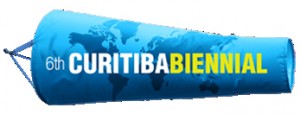6th Curitiba Biennial
“Beyond the Crisis”
18 Sept. – 20 Nov. 2011
Curators: Alfons Hug and Ticio Escobar
When it comes to key words of the present, we do well to examine their precise linguistic background. The word ‘crisis’ deserves special attention in this context. After all it is omnipresent these days, almost a background noise, and dominates discourse in ever new combinations, from economy to culture.
Goethe already trembled before the “incessant vertigo of purchasing and consumption” and wondered how the rubble of his grandfather’s house, destroyed in the war, could be worth twice what the house was worth before the war. But how is something turned into money, and how do you calculate its exchange value? Is it work, the market, its scarcity or perhaps desire?
In Greek, κρίσις (krísis) originally meant ‘the opinion’, ‘assessment’, later a problematic decision-making situation. The term has been documented since the 16th century in medicine, where it denotes a critical point in the progress of a disease and a marking between life and death.
Whereas crisis used to be a worsening of a situation and a turning point, today it has become a ‘permanent crisis’, i.e. a never-ending protraction of intolerable conditions.
However, the verb κρίνειν (= to distinguish, separate) is the root not only of ‘crisis’, but also of ‘criticism’, a fortunate circumstance that opens up great opportunities for art to exert influence.
Art operates both inside and outside the crisis. Inside because it refers to it formally and conceptually, and outside, because it transcends the crisis and offers alternatives to society. Inasmuch as in art a title is just a hint of a theme to be viewed freely by the artists, it is intended that the name “Beyond the Crisis” will inspire poetic production and guide the reflection upon certain key issues of contemporary art.
The word “crisis” is used here in its most evocative sense, as the crucial moment in which a sudden change of paradigms requires new decisions, positions and new images. The term “beyond” does not exactly mean “after”; it points rather to an intermediate area, an unfolding or a third place from where one can see the crisis from the inside/outside.
The word “beyond…” may allude to that in a strict sense the critical moment has passed (always the algid point marks a situation that has already happened: therefore, it may be named). “Beyond” may also refer to the need to consider other places from where one must face the crisis, in a different and creative way. It could even mark the requirement of imagining a space-time outside the realm of critique. Art cannot renounce its utopian call: imagination is always an anticipatory device and also an enabler. Even the most negative and melancholic operations in contemporary art point secretly to a “beyond…”, to a waiting area or to an imminent event.
We do not expect the invited artists to offer recipes for the crisis, nor to express their dramas, but rather to propagate points of view: the positions that they take when facing the crisis require imaginative efforts that can open perspectives and different ranges of perception.
Art faces crisis by constantly questioning its own representation systems, discussing once and again the definition of art and its institutional circuits (museums, markets, biennials, theories, etc.). From this standpoint crises are productive, because art necessarily depends on moments of conflict and tension. Precisely, art is one of the main devices with which contemporary culture can count on to put under questioning its own statements, to renew its values and codes and to prevent the collective perception from accepting a fixed concept of the social.


